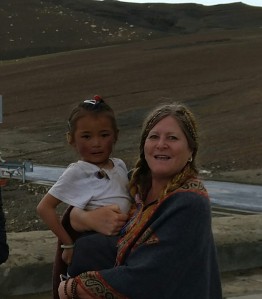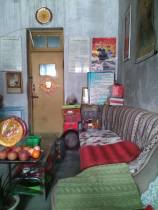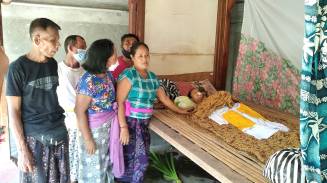Occasionally, looking back at my travel photos tends to make me melancholy. Then I start looking forward and contemplating my dreams, the destinations I haven’t yet visited and those I want to return to. There’s a quote (author unknown) that says, “It’s better to look back on life and say, I can’t believe I did that…than to look back and say I wish I did”. When I look back, sometimes I can’t believe it’s my life I am looking at. Did I really do all those things, go all those places, and meet all those people? Occasionally, a few tears are shed. Not necessarily in sadness, although I will probably never see most of these faces again, I am happy that they crossed my path and left something on my heart and in my soul. Here are a few faces and their stories:
I moved to China in August 2015. Not really knowing what to expect. Not skilled in the use of chopsticks and certainly not prepared for squatty potties, I landed in a rural village that wasn’t even named on a map in Shandong Province…Xiashan. Xiashan is considered part of the city of Weifang which is a 1.5-hour bus ride away.

The rural village was the epitome of “build it and they will come”. While the 4-5000 residents of the village lived in simple homes, it was surrounded by 100’s of high-rise “ghost” apartments, one of which I lived in. Since the newly built school was a boarding school and when school was in session, the population of the community more than doubled because of the student population, I guess they were hoping that the families that traveled (some over 4 hours) to Xiashan would invest in the real estate. I soon discovered I would be teaching grades 1, 2, and 4 at Wiefang-Xiashan Bilingual School. The students arrived staggered by grades as the small community couldn’t handle the huge influx all at once. Soon all had arrived, and it was time for the school year to kick off. We had a huge outdoor opening ceremony.

It was here that I first met Li Zi Han, aka “fish lips” because she was prone to making fish lips whenever her photo was taken. She made up to me that day and I soon found out I would be her English teacher as she was in grade one. She looked for me every day at the start of school and anytime in between. Whenever I taught in her classroom, she always tried to be my helper. She loved music and was always dancing. She told me, with the help of a Chinese teacher interpreting, that she wanted to be a dancer when she grew up. Her parents were physicians and I’m not sure her dream would be accepted by them. 
I visited the school a couple years after I left and met up with her again. She still had dreams of dancing, but what has become of her since? Will she follow her dream? Questions I will probably never have answers to. Her face will forever be the one that I think about when I reminisce about my days in Xiashan.

The “Roof of the World”, the “Land of Snows”, “Bod”, or Tibet, the highest region on earth with an average elevation of 4,380 m (14,000 ft) has always fascinated me. While Tibet is governed by China and it is known as Tibet Autonomous Region, there is tension regarding its political status. There are dissident groups that are active in exile, along with the current or 14th Dalai Lama who went into exile in 1959 and currently resides in Dharamshala, India. Living in Hunan Provence at the time, I knew it was the perfect opportunity for me to visit Tibet. I also discovered as a foreigner I could not enter Tibet as an individual but must enter as part of a group with an authorized guide. In July 2016, after securing a Tibet Travel Permit and finding a guide and tour group that fit my agenda, I took a 53-hour train ride from Guangzhou, China to Lhasa, Tibet. I was met by an armed guard exiting the train and escorted to an area where my passport and travel permit were checked. It was here I was met by my group’s guide and was taken to my hotel in Lhasa. I arrived a couple of days before the tour started so I could have some free time in Lhasa.
One of the must-do items when choosing my itinerary was an overnight at Mount Everest Base Camp. Everest Base Camp is either of two base camps on opposite sides of Mount Everest. South Base Camp is in Nepal at an altitude of 5,364 meters (17,598 ft) (28°0′26″N 86°51′34″E), and North Base Camp is in Tibet at 5,150 metres (16,900 ft) (28°8′29″N 86°51′5″E). These camps are rudimentary campsites on Mount Everest that are used by mountain climbers during their ascent and descent. Supplies are shipped to the South Base Camp by sherpas or porters, and with the help of animals, usually yaks. The North Base Camp has vehicle access (at least in the summer months). Climbers typically rest at base camp for several days for acclimatization to reduce the risks and severity of altitude sickness. Being in Tibet, we had vehicle access to base camp. The road to Everest Base Camp from Lhasa covers 613 kilometers and passes through Gyantse, Shigatse, Lhatse and Tingri. It was on this road in the village of Mêmo in the Qomolangma (Tibetan name for Everest) Nature Preserve, I had my first glimpse of the mighty Mount Everest. Qomolangma National Nature Preserve houses two of the poorest counties in China. Local livelihoods depend predominantly on nomadic herding.  It was also here that I stepped behind a concrete slab and put on my best OMG face as I pointed to the mountain.
It was also here that I stepped behind a concrete slab and put on my best OMG face as I pointed to the mountain.

I then looked down and saw a pair of black eyes looking up at me. The eyes belonged to a small Nomad girl. She was dressed in just a t-shirt and smiled at me with chapped cheeks. She reached for me, and I picked her up and one of my travel mates snapped a photo of us. I ended up buying Tibetan prayer flags from her mother. Cathy, these are the ones hanging on your porch.
“Nomad children today hold the key to future wise use of the rangelands and continuance of the nomadic way of life. Their education and health is critical. They must learn new skills for handling animals and acquire the knowledge and expertise that will allow them to continue to use the rangelands with dignity. As long as nomads, imbued with a sense of the sacredness of the landscape, are allowed to move in harmony with their animals across the grazing lands of the Tibetan Plateau and Himalaya, there is hope for the future. If we help enable this to happen, young nomads will have heroes they can identify with, and the world will be a better place for all of us.” (Daniel J. Miller, The World of Tibetan Nomads)
I often think of those chapped cheeks and black eyes and wonder what the last 6 years have brought her. A face I will never forget.

It was Qingming Festival in China (April 2018). I decided to take the time and check a bucket list item, to see Laolongtou (老龙头) or the ‘Old Dragon Head’. This is where the Great Wall of China begins\ends at the Bohai Sea.


The Qingming or Ching Ming festival, also known as Tomb-Sweeping Day in English, is a traditional Chinese festival that falls on the first day of the fifth solar term of the traditional Chinese lunisolar calendar. This makes it the 15th day after the Spring Equinox, either 4 or 5 April each year. Laolongtou (Old Dragon’s Head), so named because the Great Wall here resembles a dragon drinking water from the sea is located three miles (five kilometers) south of Shanhaiguan and about 190 miles (305 km) away from Beijing.
The Laolongtou Great Wall was built in 1381 under the supervision of Qi Jiguang, a general of the Ming Dynasty (1368 – 1644). It was an important line of defense against enemies coming from both the land and the sea. After the founding of the Qing Dynasty (1644 – 1911), its military function faded, and it turned into a great tourist destination, attracting numerous visitors to enjoy the seascape and surrounding constructions.

My teaching assistant Alice accompanied me on this trip. After visiting Laolongtou, we decided to travel about 15 km and see the Jiumenkou section of the Great Wall of China. The Jiumenkou Great Wall was built in 1382 by the Ming Dynasty (1368–1644) in this strategic area of a valley that that was an important pass allowing access inland. It was built during the reign of Emperor Hongwu (1368-1398). This portion of wall is the only part of the Great Wall that crosses a river. So it is a unique section of the 8,850-km (5,500-mile) Ming Great Wall that stretched from Hushan on the North Korean border almost to Xinjiang far in the west. It also has a troop tunnel 1,027 meters long carved out under the wall perhaps to house troops or for use to hide troops in the event of an attack . It is thought 1000 soldiers could stay in it.




While walking around this area we stopped in a temple, and we met an 83-year-old monk. She invited us to her simple home to share some fruit. Since I had Alice with me to translate, I thought it was an opportunity I couldn’t pass up. We spent about an hour with her, eating fruit and listening to her stories. Another face, another soul that has crossed my path that I often think about and wonder.

After living 4 years in China, I made the decision to leave in 2019 and move to Poland in 2020. Before moving to Poland and before spending the holidays in the states for the first time in 8 years, I decided to return to the island that stole my soul…Bali. This time the plan was to live there for 4-6 months. I also wanted to spend some time volunteering at a Balinese school for special needs children. I ended up spending 6 weeks living and working at Yayasan Widya Guna in Bedulu, Bali, Indonesia. Yayasan Widya Guna is an Indonesian non-profit organization whose focus is its children’s learning center. It serves Balinese children who come from unfortunate situations. They have taken in orphans and provided them with food, shelter, and an education. They support children with all ranges of physical and/or mental disabilities, including but not limited to, downs, autism, and cerebral palsy. They also offer English lessons to the village children after their regular school day is over, free of charge. Its mission is to: Educate the underprivileged Balinese children to be independent and bring them a better future with their own knowledge, culture, and skills. Ketut Sadia is the founder of the school. He encourages volunteers to use his homestay. Just like at Kenari House, I paid for a room in the homestay. By using the homestay of the school, the monies you pay for accommodation directly support the school. Also, in exchange for your volunteer time, the homestay provides 3 meals a day at no additional cost.

On day 1 arriving at the school, noticing a new face, I was bombarded by kids wanting a hug, asking “what’s your name?” … you get the picture. I soon learned that each morning, the day is started with meditation. The meditation is guided by a teacher at the school and consists of 30 minutes of music to which the children have learned simple movements such as tapping the head lightly with their fingers and progressing down their body. I was amazed how the children followed the guidance and were quite calm at the end of the 30 minutes which concluded with a lively dance routine. It was during this time I also noticed many adults who seemed to be parents of some of the children. Indeed they were and I learned they spend part of the school day on-site and help with things such as cleaning, maintenance, food preparation, and preparation of the canang sari or daily offerings. I was assigned to my classroom which as it turns out, was the “active” group…think herding kittens.




One of my students was a smallish boy named Juna. Mostly non-verbal and had a physical disability that affected his mobility. Although he managed to walk and run, I was always waiting for him to topple over. His father spent most of the day at the school and was always concerned with Juna’s welfare and assisting the teachers with Juna as much as possible.

They came and went from school on a motorcycle. Each day as they were leaving they would pass me on the road and stop. I would stop and Juna would give me a crooked smile and a high five. Sadly, on April 5th I awoke to the news that Juna had passed away…fly high sweet boy!

So many beautiful faces have crossed my path during my journey “Down the Rabbit Hole”. As I look back on my travel photos, I want to tell their story. I wonder where they are now. What are they doing? Are they happy? Have they followed their dreams? Are they still alive? Some are nameless, some I still have contact with, most I will never see again, and some I never formally met, but they have all touched me in some way. I want to remember how I felt, where I was and what I was doing when our paths crossed. My life has been blessed with these beautiful people.

Beautiful interesting faces and stories! Thank you.
LikeLike
Beautifully written as always, touching accounts of the footprints in your life! Another chapter my friend
LikeLike
Wendy,
I really admire you want for knowledge and adventure. While I look back on my adventures some very concerning (luckily I might have been a bit young to really care about the consequences). Still I envy your drive for more. Just stay safe and enjoy the ride!
LikeLiked by 1 person
Ray, thank you for the kind words and taking the time to read and comment on my blog. I hope all is well. I’m off to Bulgaria for the summer soon. Take care…
LikeLike
Those flags are still there, flying high after all these years. Precious memories.
LikeLiked by 1 person
I have to get mine hung on N. Park
LikeLike